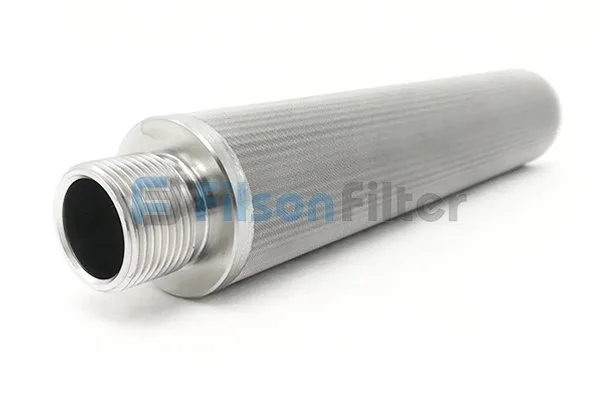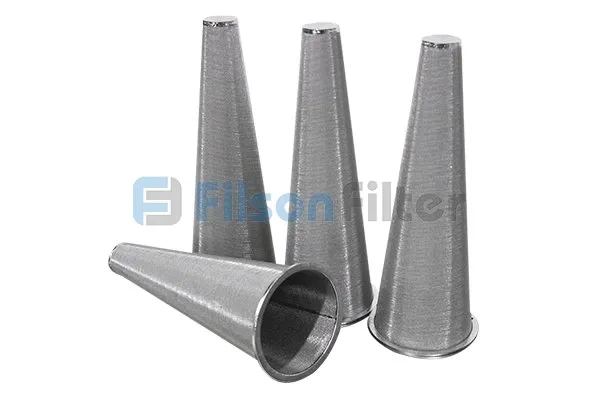Filson Sintered Nickel
- High purity sintered nickel construction for good corrosion resistance
- Outstanding thermal resistance ranging up to 800 – 1200°C
- Good regeneration ability and simple cleaning for long term use
- Able to be applied to highly concentrated acidic liquids
- High filtration efficiency up to 99.9%
- Specifications
- Send Us Inquiry
Filson sintered nickel, also known as sintered nickel filter, is a kind of sintered metal filter provided by Filson. Manufactured with pure nickel ( nickel purity up to 99.8% ), Filson sintered nickel is featured with good properties to meet any of your requirements.
- Construction material: standard nickel or nickel alloy
- Operating temperature: 800 – 1200°C
- Filtration accuracy: 1 – 200μm
- Filtration efficiency: 99.9%
- Shape: pipe, tube, plate, sheet, disc, ring, bar, foil, cone, cylinder, candle
- Length: up to 1200mm without welding
Others: special requirements of dimensions can be satisfied at Filson.
Send Your Inquiry Today
Filson Sintered Nickel
Your Reliable Sintered Nickel Supplier in China
Filson sintered nickel is typically designed and constructed with nickel wire mesh or nickel powder, formed through a sintering process. It is regarded as an ideal filter media which can be applied to various industries.
Filson sintered nickel is highly resistant to temperature and can be used in tough thermal conditions with heat up to 800 – 1200°C, even much higher than the popular stainless steel material which can resist high temperature up to 600°C.
Another important benefit provided by Filson sintered nickel filter is its excellent corrosion resistance to highly corrosive fluids, such as hydrochloric acid and sulfuric acid. Meanwhile, the sintered nickel filter can easily meet the seawater desalination and chemical liquid filtration.
Filson has a complete sintered nickel production line to guarantee a timely and adequate supply for your needs. If you need sintered metal filters of other materials, such as sintered stainless steel filter, sintered titanium filter, sintered bronze filter, etc, we can also provide you with high-quality products. Contact Filson today, and we are willing to have a cooperate with you sincerely.
Sintered Nickel: The Ultimate FAQs Guide
This guide covers everything you need to know about sintered nickel such as features, manufacturing process, uses, quality testing, porosity, and classification, among other aspects.
So, if you want to be an expert in sintered nickel, read this guide.
- What is a Sintered Nickel?
- How can you Manufacture Sintered Nickel?
- What is the Composition of Nickel?
- What are the Features of a Quality Sintered Nickel?
- What Kind of Applications requires the use of Sintered Nickel?
- How does Sintered Nickel compare to Standard Nickel?
- What Factors affect the Quality of Nickel Sintering?
- How does Sintered Nickel compare to Sintered Stainless Steel?
- Why use Sintered Nickel to construct your Filters?
- What Factors should you consider when Selecting Sintered Nickel?
- Are there Different Grades of Sintered Nickel?
- What is an Isostatic Pressing of Sintered Nickel?
- What Quality Test can you Perform on a Sintered Nickel Filter?
- How can you Sinter Nickel through the Direct Metal Laser Sintering (DMLS) Process?
- How does Porosity Affect the Mechanical Properties of Sintered Nickel?
- How do you Clean Sintered Nickel?
- What Application use Sintered Nickel Porous Filters?
- What is a Nickel Alloy Sintered Metal?
- How do you Prepare a Nickel Powder Sintered Material?
- What Types of Sintered Nickel Filters are there?
- How long can a Sintered Nickel Filter last?
What is a Sintered Nickel?
Sintered nickel is a type of porous metal fiber that is constructed by pressing nickel or pre-alloyed nickel powder into tubes or sheets then subjected to high-temperature sintering.
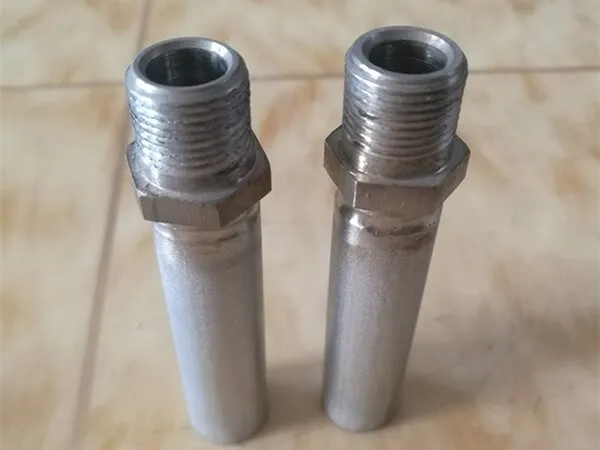
Sintered nickel filter
How can you Manufacture Sintered Nickel?
Sintering nickel follows a similar procedure to sintering any other metal powder.
Initially, you need nickel powder and tooling to initiate the sintering process.
· Nickel Powder
You can use pure nickel powder or alloyed nickel powder.
The characteristics of the final product will depend on the chemical composition of the nickel powder you used.
Depending on the nature of your nickel powder (laminar, spherical, irregular, sponge), you will acquire a product with diverse component properties.
· Mixing/Blending
You can start by adding nickel then mix with different alloying elements as you desire.
Add a solid lubricant to reduce friction between the surface of the compaction tool and the powder mass.
You can also add any special additive that is required by the process.
The resulting material is a homogeneously mixed powder with additives of the desired properties that will ensure very low friction during compaction.
You can achieve the desired physical, chemical, and mechanical properties through a strict dosing and control process.
· Tooling
This is a high precision and durability equipment that facilitates the compaction of the powder mixture.
It possesses a negative shape to that of the end product.
· Compaction
Fil the tool cavity with the powder mixture through gravity then apply a uni-axial pressure in the range between 200 to 1, 500 MPa.
The amount of pressure applied will depend on the density desired for the end product.
You will end up with a compacted part, the ‘green part’ coming out the tooling which has a density of between 85 to 95%.
The green part can be handled because it has some level of mechanical stability.
It also has the desired shape that has not yet achieved its final dimensions therefore you have to make allowances for shrinkage during sintering.
· Sintering
You will conduct the sintering process inside a conveyor/continuous furnace under a controlled environment.
Heat the compacted parts to a temperature below the melting point of nickel for a period predetermined to the final part application and physical properties.
The sintering heat varies between 750 t0 1300C depending on the grade of nickel alloy and desired characteristics to be achieved.
High-temperature heating creates bonding between the particles of the ‘green’ part through diffusion bonding.
The procedure creates a product with enhanced mechanical properties.
Sintering also results in minor shrinkage which gives the final product the required dimensions.
However, you can still adjust the properties of the product by adjusting its cooling rate.
The controlled environment in furnace heating can be a vacuum, hydrogen atmosphere, dissociated ammonia, endothermic gas, or a nitrogen-hydrogen atmosphere.
What is the Composition of Nickel?
Nickel is a naturally occurring metal found in the earth’s core and crust.
The metal has superior physical, chemical, and mechanical properties that make it desirable for several industrial applications.
What are the Features of a Quality Sintered Nickel?
High standard and quality sintered nickel should possess the following qualities:
- Withstand high operation temperatures ranging from 800°C to 1200°C
- Uniform pore size distribution
- Excellent air permeability
- Excellent plasticity, rigidity, and mechanical strength
- Easy to weld, mechanize, and bond
- Have excellent resistance to chemical corrosion and can withstand nitric, acetic, sulfuric, oxalic, hydrochloric, and phosphoric acids. Furthermore, it also has great working stability under a high concentration of nitrogen, molten sodium, water vapor, hydrogen, acetylene, and carbon dioxide gas.
- Possess an excellent forming process and can reach up to 1200 mm in length without welding.
- Has very high material effectual usage rate and is more suitable for use in complex and batch structures
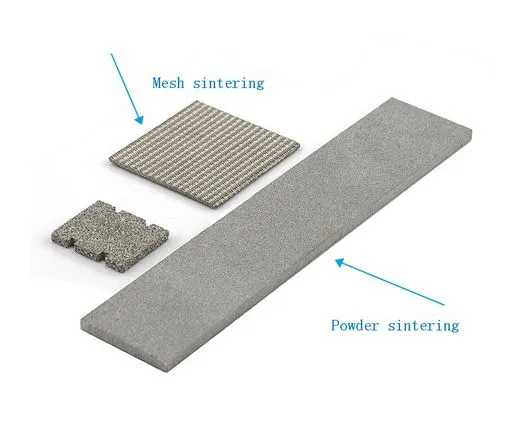
Sintered Nickel Sheet
What Kind of Applications requires the use of Sintered Nickel?
Sintered Nickel and sintered nickel-based alloys are very useful in applications that operate under novel high temperatures and extreme corrosive conditions.
Some of the applications that utilize Sintered nickel and sintered nickel-based alloys include:
- Gas turbines
- Nuclear reactors
- Marines
- Steam power plants
- Petrochemicals equipment
- Mining industry
- Food and beverage industries
- Automotive industry
- Aircrafts industry etc.
How does Sintered Nickel compare to Standard Nickel?
Sintered nickel produce fibers which have increased mechanical and tensile strength compared to non-sintered nickel.
Sintering also improves product resistance to heat, oxidation, and corrosion among other benefits.
What Factors affect the Quality of Nickel Sintering?
The quality of sintered nickel depends on numerous factors including:
- Heating rate
- Sintering temperature
- Sintering time
- Sintering method.
- Cooling rate
- The shape of metal powder
- Forming conditions
- Molding process
- Sintering atmosphere
- Sintering method
- Sintering and pressing conditions etc.
Among these factors, sintering time and temperature are more critical because they affect the strength, hardiness, porosity, and density of the sintered part.
For instance, product performance will be significantly lowered by excessively high temperatures or too long sintering time.
Similarly, too short sintering time or low temperature will produce poorly sintered nickel with lower properties.
How does Sintered Nickel compare to Sintered Stainless Steel?
Sintered nickel and nickel-based-alloys come in handy under conditions where the special heat resistant and corrosive properties surpass that of sintered stainless steel.
You can use nickel-based alloys such as Monel and Hastelloy in acidic waters that would otherwise cause stainless steel to rust through crevice corrosion.
Hastelloy and Inconel support operations in extreme temperatures and severe corrosive conditions that stainless steel cannot withstand.
Why use Sintered Nickel to construct your Filters?
Sintered nickel provides the best construction material for making filters that operate under an extreme temperature of up to 1200°C and hostile environmental conditions.
Sintered Nickel and sintered Nickel based alloys filters also possess the following qualities which can be essential to the specificity of your operations.
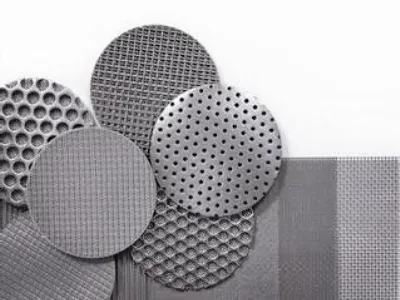
Sintered Nickel Mesh Filter
- Possess high-temperature strength
- Very stable in an oxidative and corrosive environment
- Excellent resistance to chemical corrosion and other reducing agents
- Excellent mechanical and tensile strength
- Possess a high filtration precision
- Excellent permeability and very low-pressure loss
- Very high porosity, uniform pore size, and minimal initial resistance
- Suitable for filtration of fluids that require homogenized treatment and high uniformity in fluid distribution.
- Possess a large flow area, low differential pressure, excellent regeneration ability, and long service life
What Factors should you consider when Selecting Sintered Nickel?
You should consider the following factors when choosing sintered nickel or nickel-based alloys for your application:
- The operating temperature of your application
- The environmental working conditions: How corrosive or oxidative?
- Compatibility with process fluids or materials
- Porosity and permeability
- The ductility, weldability, and machinability
- Tensile and mechanical strength
- Pore size and pore distribution
- Effective filtration area
- Presence of chemical, acids, and other reducing agents
Are there Different Grades of Sintered Nickel?
Yes, you there are grades of different sintered Nickel. However, these grades are mostly alloys of nickel which have been sintered.
What is an Isostatic Pressing of Sintered Nickel?
Isostatic pressing is a forming process used in powder metallurgy to compress materials into a variety of shapes and sizes through reducing the porosity of the powder mixture.
The process optimizes distribution and uniformity in density and microstructure through the application of equal and uniform pressure on the powder compact.
There are three types of isostatic pressing:
- Cold isostatic pressing: Uses pressure ranges as low as less than 5, 000 psi to more than 100, 000 psi to compact metal powder in elastomeric molds at room temperature.
- Warm isostatic pressing: Similar to CIP though the temperature is elevated to 100°C
- Hot isostatic pressing: This technique simultaneously applies both elevated temperature (2, 200°C) and pressure to increase the density and eliminate porosity.
What Quality Test can you Perform on a Sintered Nickel Filter?
You can perform the following test to ascertain the quality of a sintered nickel filter you select.
- Filtration efficiency test through Multi-pass test
- Collapse pressure test
- Dust holding capacity test
- Pressure drop test
- Element cleanability test etc.
How can you Sinter Nickel through the Direct Metal Laser Sintering (DMLS) Process?
DMLS is a fascinating 3D printing technology that enables you to design and print any metal.
It is the most widely used metal printing technology and can create intricate metal parts.
The technology follows a similar sequence as other 3D technologies including modeling, slicing, and layer by layer printing.
Initially, you create a 3D model and slice with a suitable software then feed the printer with an appropriate code needed for creating the part.
Follow by initiating physical printing.
Consequently, fill the printer hopper with nickel powder which then heats it to near the sintering temperature.
The printer protects the heated powder and the building parts using an inert gas.
The printer initiates the building process through dispensing a thin layer of nickel powder on the building platform then selectively creating a solid through sintering the powder.
The process continues until the project/object is finished.
Cool the object then remove any remaining loose metal powder in the surrounding.
Remove the support and conduct any post-sintering treatments such as surface finishing, machining, or heat treatment.
How does Porosity Affect the Mechanical Properties of Sintered Nickel?
Porosity is a key factor that influences the functional characteristics of sintered nickel and sintered nickel-based alloys.
Given that porosity is inversely proportional to density, then then it will negatively impact on material hardness, tensile, and impact strength while corresponding to properties like ductility.
Furthermore, porosity will also affect other mechanical factors such as fatigue limit, surface roughness, fatigue resistance, rapture elongation, electric conductivity, etc.
How do you Clean Sintered Nickel?
Cleaning sintered porous material can be challenging compared to other non-porous fiber or material.
You can use several methods such as backwash, back pulse, or ultrasonic techniques to clean a porous material.
The ultrasonic cleaning method is universally accepted and has provided sufficient results compared to other methods in cleaning sintered metal products.
However, the porous nature of the material requires more than just dipping the material in an ultrasonic machine for a given time duration.
The main challenge involved in cleaning porous parts is the potential of recontamination due to the seeping of dirt from the interior to re-contaminate the surface.
Furthermore, the entrapment of particles inside the porous fiber magnifies the problem.
You can overcome the above challenges by using methods that force the cleaning liquid through the porous material.
In the case of filters, you should provide a flow direction in reverse to the normal filtration flow.
Where the flow direction is indeterminate, then you can rotate the parts to ensure cleaning fluid is originating from all directions.
You can also achieve similar results by multi-dipping the material in the cleaning fluid in cases where forcing the cleaning fluid to penetrate the material is not feasible.
However, you have to drain out the cleaning liquid in between dips for optimal results.
What Application use Sintered Nickel Porous Filters?
You can use a sintered nickel porous filter over a wide range of applications that operate under very harsh conditions.
The filters should be able to withstand extreme temperatures exceeding 1000C.
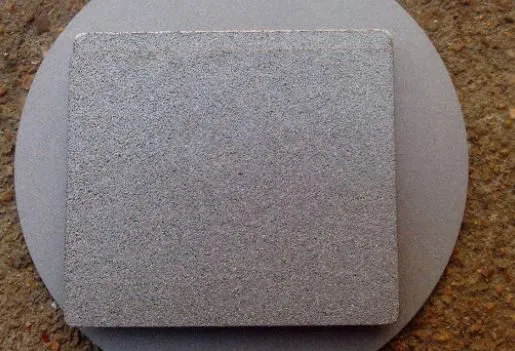
Sintered Nickel
Some of the applications that require the use of nickel porous filter include:
- Filtration in the petroleum industry
- Oil filtration in the refining process
- Viscose filtration
- Filters for protection of vacuum pumps
- Support body for filter membranes
- High-pressure reverse washing
- High-temperature environment filtration
- Filtration of acids and alkalis or corrosive environments
- Filtration in pharmaceuticals industries
- Gas-liquid separation
- Gas-oil dissociation
- Air purification
- Solid-gas separation
- DE dusting, isolation dust
What is a Nickel Alloy Sintered Metal?
You can easily mix pure nickel with diverse types of metals such as chromium, copper, iron, and molybdenum to form new products.
The addition of nickel enhances the desired product characteristics such as resistance to oxidation or corrosion, reduction of the coefficient to thermal expansion, and tolerance to high temperature.
You can construct the sintered alloy through powdering the raw material, screening, molding then sintering to achieve the final product.
Some of the common high temperature sintered nickel alloys include:
· Nickel-iron Alloy
You can use a sintered nickel-iron alloy if you desire to acquire a material that has a lower rate of thermal expansion.
The alloy exhibit as low as a one-tenths coefficient of thermal expansion exhibited by carbon steel.
Following these properties, you can use this alloy in applications such as thermostats and precision measurement equipment.
You can also use them for constructing indicators, memory storage devices, and transformers which require materials with soft magnetic properties.
· Nickel-copper Alloy
Commonly referred to as Monel, this alloy type is very resistant to salty seawater and hence best suited for an application operating under the marine environment.
You can use it to construct pump shafts, pipes, filters, valves, etc. for marine applications.
· Nickel-Molybdenum Alloy
The type alloy offers very strong chemical resistance to acids and reducers such as hydrogen chloride, hydrochloric, sulfuric, and phosphoric acids.
You can use this alloy to construct filters, valves, pumps, gaskets, pipes, heat exchangers, etc. that are used in an application with strong acids.
· Nickel-chromium Alloy
The alloy is suitable for constructing equipment that has a high-temperature strength, high corrosive resistance, and high electrical resistance.
You can use it for making heating elements such as electrical resistance heaters, toasters, or production of wires like Nichrome ® wire.
· Nickel-Chrome-iron Alloy
The alloy is suited for constructing equipment with superior resistance to high-temperature corrosion and oxidation.
They are highly valued for their optimal rapture and creep characteristics at high temperatures.
You can use them to construct equipment such as furnace cracker tubes and sheaths for electrical elements.
· Nickel-Chromium-Molybdenum Alloy
The alloy has similar applications to Nickel-molybdenum alloy though it comes with enhanced corrosive resistance to reducing acids.
Some of the common trade names for this alloy include Hastelloy C276 and Inconel 276.
In addition to the three primary elements, you can also add trace amounts of manganese.
The alloy is best used for constructing scrubbers, stack liners, and ducts for pollution control and components for processing chemicals such as reactor vessels, and heat exchanges.
· Nickel-chromium-cobalt Alloy
They have enhanced creep and rupture strength as a result of the addition of chromium and molybdenum.
You can use the material for constructing components for industrial furnace, catalytic grid support for nitric acid production, gas turbines, and facilities for producing fossil fuels.
· Nickel-Titanium Alloy
The type alloy has a unique property of ‘shape memory’.
You can form a shape at an elevated temperature.
That is, you deform at a lower temperature but then the material remembers the initial shape once your heat it to the transition temperature.
The super-elasticity of this alloy makes it suitable for manufacturing shock absorbers that help protect buildings from damages caused by earthquakes.
How do you Prepare a Nickel Powder Sintered Material?
You can produce high purity nickel powder using the carbonyl refining process.
This process is a widely used and most preferred method because it can produce a very pure product through low energy consumption. it also produces the least pollution levels.
Production of nickel powder commences at the nickel oxide feedstock where you continuously supply nickel oxide to a reduction kiln.
The process tumbles the nickel oxide through a stream of purified hydrogen at 230°C and produces granulated, impure nickel.
Secondly, the nickel reacts with carbon monoxide in the volatilization kiln at near atmospheric pressure and produces nickel carbonyl gas.
The gas is thermally decomposed into pure nickel through gentle heating.
For the production of nickel powder, feed the gas on top of the decomposing towers at a metered rate while heating the tower wall at temperatures between 300 to 500°C.
The gas settles at the bottom of the tower following instant decomposition.
What Types of Sintered Nickel Filters are there?
You can make diverse types and configuration of sintered nickel filters including:
- Particulate filters
- Coalescing filters
- Filter screens
- Depth filters
- Pleated filters
- Disc filters
- Porous filter plates
- Microporous sintered Nickel filters etc.
How long can a Sintered Nickel Filter last?
The period of the service life of a sintered nickel filter depends on the dirt loading of the incoming fluid, the dirt holding capacity, filter size, system flow rate among other factors.
Filters constructed using high porosity sintered nickel fibers have high dirt holding capacity and can last double the time taken by a standard filter.
Consequently, with well scheduled and efficient cleaning, a porous sintered nickel air particulate filter can offer sufficient filtration for 5 to 15 years.
The long service life of the filters is desirable because they lower the filter-change-out costs.
FilSon Filters has years of experience and expertise in sintered nickel.
Contact us today for competitive prices on sintered nickels.
